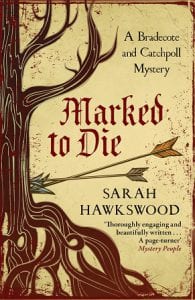The Medieval Sniper: Guest Post by Sarah Hawkswood
Today we’re handing over the blog to author Sarah Hawkswood, whose third book in the Bradecote & Catchpoll series, Marked to Die, comes out in paperback today. Read on to learn about how a medieval archer compares to a modern sniper…

You might say that there is no mystery whatsoever to Marked to Die, since the very first paragraph tells you that the murders are committed by an archer. However, I would say he is more the method of killing, and as in all my Bradecote and Catchpoll novels, it is more about how three twelfth century men find a killer than putting the reader through a series of clues for them to play Sherlock.
The idea of the Archer and that first paragraph was the inspiration for the whole book, and I wrote the scene some months before I had formed a full plot. I saw him not as a murderer in the usual sense, but very much in the mould of the modern sniper, though not the contract killer. A contract killer would generally research their victim, know at least a little about their ‘hit’ but the Archer could not tell you anything about those he brings down, and has no point of contact beyond the piercing of his arrow just as the sniper has no contact beyond the round that finds its mark. He kills without malice, but seeks perfection in every loosed arrow. This is his trade and he is a master of it, not some standard man-at-arms who can use a bow; he is way above that. He kills at long range and, as with the sniper, it is not about eyesight, but focus and breathing, and being at one with the weapon. The Archer has a bond with his bow that means that it is when combined that they become deadly. The bow is otherwise just an inanimate piece of wood and he is a man who is not violent or aggressive. He just carries out his craft as best he can, to his mind like a wheelwright or a swordsmith. He is even rather moral, with the one caveat that he has taken a step back from seeing the ending of people’s lives as wrong. This is of course a really major flaw, but he has a code. He would never think to steal from those he kills, and in the course of the book takes some actions that are laudable.
The thing which stands out about him is that he has become a loner, very self contained, with no emotional connection to other people. That he did have such bonds in the past is clear, familial and to his lord, but since the latter’s death he has withdrawn. This may well be to do with his refusal to think upon the consequences of his actions. When he was his lord’s man he obeyed his will, or was in battle, and the deaths he brought about were ’unavoidable’. On becoming lordless, his craft has kept him fed, enabled him to travel back to England, but it has been his choice to take the silver, commit the acts. The element in him which would be revolted by killing, dampened down by combat, has been put out of his mind, but to do it he has had to disengage from people. That is the price he has paid, and it is not inconsiderable.
By the end of the novel I hope the reader will be appalled by what the Archer has done, but have some sympathy and admiration for him nonetheless.
Thank you Sarah for that interesting insight! Marked to Die is currently a Book of the Month, so there’s £2 off when you order it through our website and use the code BOTM3.


